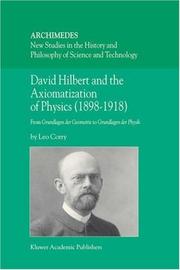| Listing 1 - 5 of 5 |
Sort by
|
Book
Year: 1963 Publisher: Paris : Gauthier-Villars,
Abstract | Keywords | Export | Availability | Bookmark
 Loading...
Loading...Choose an application
- Reference Manager
- EndNote
- RefWorks (Direct export to RefWorks)
Axioma's. --- Axiomatique --- Klassieke mechanica. --- Kwantummechanica. --- Mecanica, Elasticidade E Reologia. --- Mechanics --- Mécanique --- Science --- Sciences --- Théorie quantique --- Congrès. --- Methodology --- Méthodologie
Book
ISBN: 9053567496 Year: 2005 Publisher: Amsterdam Amsterdam University Press
Abstract | Keywords | Export | Availability | Bookmark
 Loading...
Loading...Choose an application
- Reference Manager
- EndNote
- RefWorks (Direct export to RefWorks)
510.3 --- Hoger onderwijs --- Wiskunde --- Axioma's --- Bewijzen --- Inzicht --- 507 --- Oneindigheid --- Wiskundige bewijzen --- Inleidingen - Hand- en leerboeken Wiskunde --- (zie ook: realistische wiskunde) --- Didactics of mathematics --- Didactics of secundary education
Book
ISBN: 340203932X 9783402039328 Year: 1993 Volume: 37 Publisher: Münster: Aschendorff,
Abstract | Keywords | Export | Availability | Bookmark
 Loading...
Loading...Choose an application
- Reference Manager
- EndNote
- RefWorks (Direct export to RefWorks)
Axioma's --- Axiomatiek --- Axiomatique --- Axiomes --- Axioms --- -Philosophy, Medieval --- #GROL:SEMI-1'04/14' Beit NF 37 --- Medieval philosophy --- Scholasticism --- Geometry --- Mathematics --- Parallels (Geometry) --- Philosophy --- Early works to 1800 --- Foundations --- Philosophy, Medieval --- Axioms - Early works to 1800 --- Nikolaus, - von Amiens, - active 12th century-13th century

ISBN: 140202777X 9048167191 1402027788 Year: 2004 Publisher: Dordrecht Springer
Abstract | Keywords | Export | Availability | Bookmark
 Loading...
Loading...Choose an application
- Reference Manager
- EndNote
- RefWorks (Direct export to RefWorks)
David Hilbert (1862-1943) was the most influential mathematician of the early twentieth century and, together with Henri Poincaré, the last mathematical universalist. His main known areas of research and influence were in pure mathematics (algebra, number theory, geometry, integral equations and analysis, logic and foundations), but he was also known to have some interest in physical topics. The latter, however, was traditionally conceived as comprising only sporadic incursions into a scientific domain which was essentially foreign to his mainstream of activity and in which he only made scattered, if important, contributions. Based on an extensive use of mainly unpublished archival sources, the present book presents a totally fresh and comprehensive picture of Hilbert’s intense, original, well-informed, and highly influential involvement with physics, that spanned his entire career and that constituted a truly main focus of interest in his scientific horizon. His program for axiomatizing physical theories provides the connecting link with his research in more purely mathematical fields, especially geometry, and a unifying point of view from which to understand his physical activities in general. In particular, the now famous dialogue and interaction between Hilbert and Einstein, leading to the formulation in 1915 of the generally covariant field-equations of gravitation, is adequately explored here within the natural context of Hilbert’s overall scientific world-view. This book will be of interest to historians of physics and of mathematics, to historically-minded physicists and mathematicians, and to philosophers of science.
Mathematicians --- Mathématiciens --- Axioma's. --- Mathematische fysica. --- Hilbert, David, --- Gilʹbert, D., --- Hilbert, D. --- 希爾伯特, --- Physics. --- Mathematics. --- History. --- Philosophy and science. --- History and Philosophical Foundations of Physics. --- History of Mathematical Sciences. --- Mathematical Methods in Physics. --- Philosophy of Science. --- Science and philosophy --- Science --- Annals --- Auxiliary sciences of history --- Math --- Natural philosophy --- Philosophy, Natural --- Physical sciences --- Dynamics
Book
ISBN: 9060012186 9789060012185 Year: 2001 Publisher: Houten Bohn Stafleu Van Loghum
Abstract | Keywords | Export | Availability | Bookmark
 Loading...
Loading...Choose an application
- Reference Manager
- EndNote
- RefWorks (Direct export to RefWorks)
Welke vormen van intermenselijke communicatie kunnen we onderscheiden? Welke kenmerken hebben ze en hoe manifesteren ze zich? Welke effecten hebben ze op gedrag? En in welke verhouding staan ze tot gestoord gedrag? Het antwoord op deze vragen wordt helder geïllustreerd met een groot aantal aan de literatuur ontleende voorbeelden. Zo geeft het boek een diepgaande analyse van Albee's 'Wie is er bang voor Virginia Woolf'. Speciale aandacht is er ten slotte voor het fenomeen van de paradox
communicatie --- systeemtheorie --- schizofrenie --- #GSDBP --- sociologie --- 007 --- 301 --- 616.2 --- Communication --- gesprekstechnieken --- Communication Programs --- Communications Personnel --- Misinformation --- Personal Communication --- Social Communication --- Communication Program --- Communication, Personal --- Communication, Social --- Communications, Social --- Personnel, Communications --- Program, Communication --- Programs, Communication --- Social Communications --- Communicatie --- Communicatie-axioma's --- Interpersoonlijke communicatie --- Theorieën --- Communicatietheorieën --- Communication Communicatie --- Feedback Feedback --- Métacommunication Metacommunicatie --- gedrag --- hulpverlening --- maatschappelijk werk --- filosofie --- psychische syndromen --- psychotherapie --- 1 --- 615.8 --- #GBIB:CBMER --- sociale psychologie --- 305.8 --- 499.4 --- 606.3 --- gedragsstoornissen --- psychiatrie --- psychopathologie --- Communicatie in de hulpverlening --- Systeemdenken in de hulpverlening (contextuele hulpverlening, systeemtherapie) --- Mondelinge communicatie --- Psychopathologie - Psychiatrische ziektekunde --- #KVHB:Communicatie --- #KVHB:Gedragsstoornis --- Theorie --- Communicatietheorie --- Verpleegkunde --- Verplegingswetenschap --- Mass communications --- Sociology of minorities --- Sociology of social welfare --- Social problems --- Psychiatry --- Primary groups --- intermenselijke relaties --- feedback --- interpersonele communicatie --- gedrag (mensen) --- Psychology --- pragmatiek --- Philosophy of language --- Human. --- Dutch. --- Gedrag. --- Relaties. --- Sociale relaties. --- Sociologie. --- psychologie --- communication --- #psyc:1993.1 --- Systémique Systematiek --- Comportement psychologique du personnel Psychologisch gedrag van het personeel --- Conflits (gestion) Conflicthantering --- Relations humaines Menselijke relaties
| Listing 1 - 5 of 5 |
Sort by
|

 Search
Search Feedback
Feedback About UniCat
About UniCat  Help
Help News
News